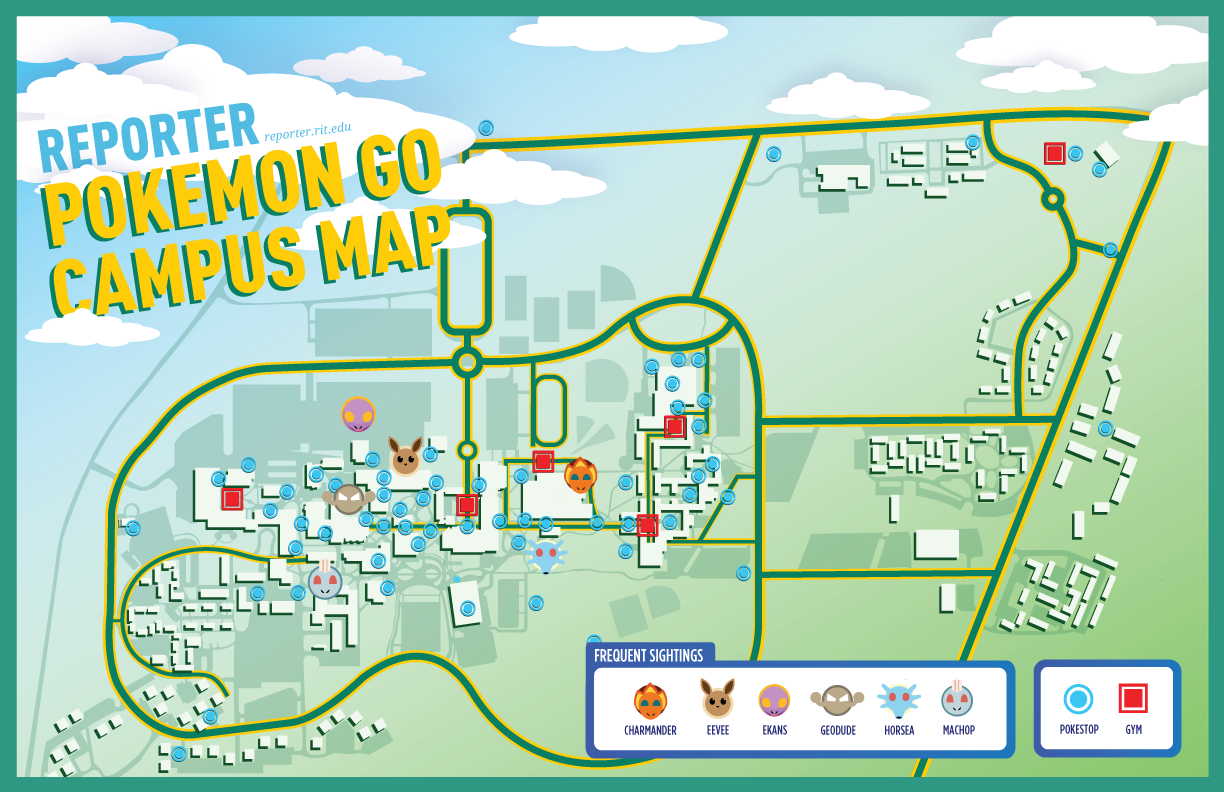Available now alongside our Orientation Issue, we at the Reporter have produced an up-to-date map on everything pertinent to Pokémon Go here at RIT. Aside from feeding our own Poke-addiction(s) we sought to provide an accurate and comprehensive guide of all the Pokestops, Gyms and spawning sites for Pokémon here on campus.
Very often host to several landmarks and pieces of public artwork – many of which were locations in Niantic's previous game "Ingress" – college campuses across the country have been prime territory to find a great number of Pokestops and Gyms. RIT is no exception as there has turned out to be quite the concentration of both here.
For those who might have been sitting on their Lures, there are several spots in which the Pokestops in close proximity overlap. Many have found that using lures on such Pokestops concurrently can make catching Pokémon that much easier, as each lure supposedly pulls from it's own pool, exponentially increasing the number that pop up; this makes it an ideal time to use a Lucky Egg and Incense as well. One can do so here on campus quite easily on the Quarter Mile right before the Gordon Field House and Activities Center, on the walkway between James E. Booth Hall and Frank E. Gannett Hall and in the open space behind Sol Heumann Hall.
[Places to utilize multiple Lures at once] One can do so here on campus quite easily:
- On the Quarter Mile right before the Gordon Field House and Activities Center
- On the walkway between James E. Booth Hall and Frank E. Gannett Hall
- In the open space behind Sol Heumann Hall.
The map also identifies what nests (specific areas where you can consistently catch the same Pokémon) are within the vicinity of campus. This was determined then by recording which Pokémon spawned multiple times in the same area for more than one person, excluding common Pokémon like Caterpie, Pidgey, Weedle and Rattata. Our findings were taken after Niantic changed where Pokémon appeared (chronicled here by Techinsider) toward the end of July and after third-party tracking websites like Pokevision were taken down.
We feel confident though that at the moment RIT has nests for Ekans, Machop, Eevee, Charmander, Horsea and Geodude. Niantic has not given any indication one way or another when or if they plan to change spawn sites again in the future, but it's worth noting that we've been unable to come across Pokémon who apparently had nests before like Growlithe and Hitmonlee.
- Ekans: Close to the Chester F. Carlson Center for Imaging Science
- Machop: Between Hugh L. Carey Hall and Orange Hall
- Eevee: Between Frank E. Gannett Hall and the Quarter Mile
- Charmander: The Gordon Field House and Activities Center
- Horsea: Between the Schmitt Interfaith CenterAugust Center
- Geodude: Between the Bausch & Lomb Center and Frank E. Gannett Hall
With almost two months between Pokémon Go's release and the start of the school year here at RIT, we as a campus have the benefit of having had several facets and issues of the game extensively (if not tirelessly) examined by users, the media and Niantic alike. For awhile it seemed like one couldn't go on Twitter, r/gaming or even your local news station without seeing someone else who had fallen off a cliff or crashed their car while playing Pokémon Go, as well as someone else confused and irritated by the flood of millennials Poke-hunting on private property – or even hallowed ground. I mean that neither as an indictment of Pokémon Go nor a claim that such issues have since been fixed (many haven't), but purely as an observation of the general awareness that now exists for such cases where people allowed themselves to be too drawn into it.
While charting the map, we certainly noticed a large number of Pokestops (as well as Nests) on, or at least in proximity to, the Quarter Mile and other adjacent paths on campus. It sounds trivial and overly-specific to think about, but with people walking, longboarding and biking in every possible direction to get to and from class, it's not hard to imagine even a usually aware pedestrian becoming momentarily distracted by a Horsea popping its head and causing someone to swerve out of control. Then again, the situational awareness necessary to avoid such an occurrence sounds no less demanding than that of those who play Humans versus Zombies. When Pokémon Go was announced last fall we talked to Dave Edborg, a Patrol Major for Public Safety, who pointed out that they'd expect students to handle it in a similar manner, with a comparable amount of attentiveness and respect for others.
In context of a potential such situation, it would be easy in a very superficial sense to claim that Pokémon Go is yet another domino toward the supposedly inevitable "cell-phone zombie" apocalypse. Yet, doing so consciously disregards all the good the app – and the technology behind it – has facilitated. Since the fervor for the game is not as hot as it was a month ago, it's easy to forget the countless stories that circulated of how it brought people together. It is inherently a very social game, so much in fact that I personally attribute it as the sole reason I have yet to finish "Stranger Things" – thanks Niantic.








